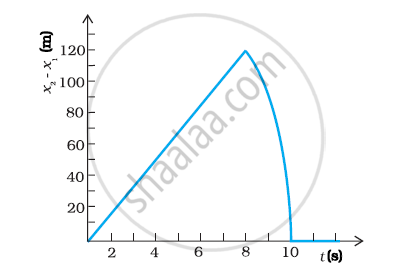Advertisements
Advertisements
Question
A man is standing on top of a building 100 m high. He throws two balls vertically, one at t = 0 and other after a time interval (less than 2 seconds). The later ball is thrown at a velocity of half the first. The vertical gap between first and second ball is +15 m at t = 2 s. The gap is found to remain constant. Calculate the velocity with which the balls were thrown and the exact time interval between their throw.
Solution
Let the speeds of the two balls (1 and 2) be v1 and v2 where
If v1 = 2v, v2 = v
If y1 and y2 and the distance covered by balls 1 and 2, respectively before coming to rest then
`y_1 = v_1^2/(2g) = (4v^2)/(2g)` and `y_2 = (v_2^2)/(2g) = v^2/(2g)`
Since, `y_1 - y_2 = 15 m (4v^2)/(2g) - v^2/(2g)` = 15 m or `(3v^2)/(2g)` = 15 m
or `v^2 = sqrt(5m xx (2 xx 10))` m/s2
or v = 10 m/s
Clearly, v1 = 20 m/s and v2 = 10 m/s
As `y_1 = v_1^2/(2g) = (20 m)^2/(2 xx 10 m 15)` = 20 m
`y_2 - y_1 - 15` m = 5 m
It t2 is the time taken by the ball 2 toner a distance of 5 m, then from `y_2 = v_2^t - 1/2 "gt"_2^2`
5 = `10t_2 - 5t_2^2` or `t_2^2 - 2t_2 + 1` = 0
Where t2 = 15
Since t1 (time taken by ball 1 to cover the distance of 20 m) is 2s, the time interval between the two throws
= t1 – t2
= 2s – 1s
= 1s
APPEARS IN
RELATED QUESTIONS
A player throws a ball upwards with an initial speed of 29.4 m s–1.
- What is the direction of acceleration during the upward motion of the ball?
- What are the velocity and acceleration of the ball at the highest point of its motion?
- Choose the x = 0 m and t = 0 s to be the location and time of the ball at its highest point, vertically downward direction to be the positive direction of x-axis, and give the signs of position, velocity and acceleration of the ball during its upward and downward motion.
- To what height does the ball rise and after how long does the ball return to the player’s hands? (Take g = 9.8 m s–2 and neglect air resistance).
A boy standing on a stationary lift (open from above) throws a ball upwards with the maximum initial speed he can, equal to 49 m/s. How much time does the ball take to return to his hands? If the lift starts moving up with a uniform speed of 5 m/s and the boy again throws the ball up with the maximum speed he can, how long does the ball take to return to his hands?
Two stones are thrown up simultaneously from the edge of a cliff 200 m high with initial speeds of 15 m/s and 30 m/s. Verify that the graph shown in Fig. 3.27 correctly represents the time variation of the relative position of the second stone with respect to the first. Neglect air resistance and assume that the stones do not rebound after hitting the ground. Take g = 10 m/s2. Give the equations for the linear and curved parts of the plot.

The velocity of a particle is towards west at an instant. Its acceleration is not towards west, not towards east, not towards north and towards south. Give an example of this type of motion .
A bullet travelling with a velocity of 16 m/s penetrates a tree trunk and comes to rest in 0.4 m. Find the time taken during the retardation.
A ball is projected vertically upward with a speed of 50 m/s. Find the maximum height.
A ball is projected from a point on the floor with a speed of 15 m/s at an angle of 60° with the horizontal. Will it hit a vertical wall 5 m away from the point of projection and perpendicular to the plane of projection without hitting the floor? Will the answer differ if the wall is 22 m away?
A bomb is dropped from a plane flying horizontally with uniform speed. Show that the bomb will explode vertically below the plane. Is the statement true if the plane flies with uniform speed but not horizontally?
A staircase contains three steps each 10 cm high and 20 cm wide (in the following figure). What should be the minimum horizontal velocity of a ball rolling of the uppermost plane so as to hit directly the lowest plane ?

It is a common observation that rain clouds can be at about a kilometre altitude above the ground.
- If a rain drop falls from such a height freely under gravity, what will be its speed? Also calculate in km/h. ( g = 10 m/s2)
- A typical rain drop is about 4mm diameter. Momentum is mass x speed in magnitude. Estimate its momentum when it hits ground.
- Estimate the time required to flatten the drop.
- Rate of change of momentum is force. Estimate how much force such a drop would exert on you.
- Estimate the order of magnitude force on umbrella. Typical lateral separation between two rain drops is 5 cm.
(Assume that umbrella is circular and has a diameter of 1 m and cloth is not pierced through !!)
